"Life is not given to us to be jealously guarded for ourselves ,but is given to us so that we may give it in turn." Pope Francis, to an audience on April 24, 2013
Information gathered from: https://catholicstewardship.com/
Stewardship Saint for June
Saint Anthony of Padua
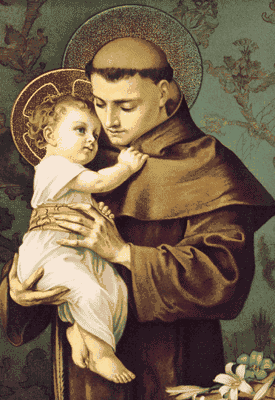 Saint Anthony of Padua is one the most beloved and admired saints in the Church. A Franciscan friar and a Doctor of the Church, he is considered one of the greatest preachers in the history of Christianity.
Saint Anthony of Padua is one the most beloved and admired saints in the Church. A Franciscan friar and a Doctor of the Church, he is considered one of the greatest preachers in the history of Christianity.
Anthony was born on the Feast of the Assumption in Lisbon, Portugal, in 1195 to a wealthy and educated family of the Portuguese nobility. He entered the Augustinian religious community at an early age where he devoted himself to the study of sacred scripture and Latin classics. He felt a call to missionary work, however, and was given permission to join the Franciscan Order when he was 26 years old.
Anthony traveled tirelessly to preach what it meant to live according to the Gospel. He is believed to have made as many as 400 trips to towns in both northern Italy and southern France where he attracted people by the thousands. He was so popular a preacher that he often had to speak in public squares and marketplaces rather than churches.
Anthony knew that preaching was not enough to help people understand how to follow Jesus Christ. He believed he had to give witness to the Gospel by the way he lived his personal life. So, he adopted and maintained a simple lifestyle consistent with what he believed the Gospel was calling him to. He became one of Francis of Assisi’s favorite disciples and closest friend.
The last months of Anthony’s life were lived in Padua, Italy, with preaching, hearing confessions, and assisting those in debt. He died there on June 13, 1231 at the age of 36 and was proclaimed a saint less than one year after his death. So simple, yet compelling and inspiring was Anthony’s teaching of the Catholic faith that he was declared a Doctor of the Church in 1946.
Anthony is best known as the saint to whom one prays to find a lost article. When a novice took his Psalter without permission, Anthony prayed for the book’s return. After the novice was visited by a ghost in a frightening nightmare, he rushed to give the book back to Anthony. Many people do not know, though, that St. Anthony is the patron of other causes. He is the patron saint of Brazil and Portugal, the poor, barren women, harvests and those who travel. His feast day is June 13.
Stewardship Saint for July
Saint Mary Magdalene, steward of Christ’s ministry
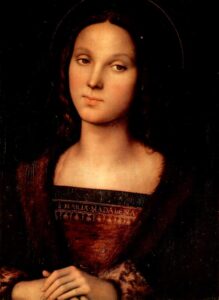
Saint Mary Magdalene is one of the most revered saints in the history of the Church and her discipleship emphasizes the complementary roles of women, Saint Peter and the other disciples as witnesses to the Risen Christ.
From the New Testament, one can conclude that Mary came from Magdala, a village on the shore of the Sea of Galilee. She was a friend of Jesus of Nazareth and a leading figure among those who were his disciples. She was one of the women who accompanied and financially supported Jesus and the twelve apostles which suggests that the women were respectable, well-to-do members of the community.
At the time Jesus was executed on Golgotha, when the men in his company had already run away and abandoned him, Mary Magdalene is specifically identified in the Gospels as one of the women who refused to leave him. She was present at the Crucifixion and burial.
What is by far the most important affirmation about Mary Magdalene, however, is that she is mentioned in all five of the Resurrection narratives of the Gospel tradition (Mark 16:1-8, Matthew 28:1-10, Luke 23:55 – 24:12, John 20:1-18, and Mark 16:9-20). In the Gospels of Matthew, Mark and John, she is the primary witness to Christ’s Resurrection. All four Gospels explicitly name her as being present at the tomb and she was the first person to preach the “Good News” of that miracle. From other texts of the early Christian era, Mary Magdalene’s status as a disciple in the years after Jesus’ death is as prominent as the twelve apostles.
For many centuries Mary Magdalene was the symbol of Christian devotion, especially that of repentance. However, Christian traditions that came after the New Testament era erroneously equated Mary Magdalene with both the sinful woman in Luke 7 who anointed Jesus and with Mary of Bethany in John 11 and Luke 10 who also anointed Jesus. The tradition that Mary Magdalene was a repentant prostitute has been dismissed by modern biblical scholarship as almost certainly untrue.
Saint Mary Magdalene has been celebrated throughout Christian history in art and literature. There are many famous depictions of her in art such as Rembrandt’s Christ and St. Mary Magdalene at the Tomb and Titian’s Nolo Me Tangere (Latin: “Do not touch me”). Her feast day is July 22.
Stewardship Saint for August
St. Teresa Benedicta of the Cross (Edith Stein)
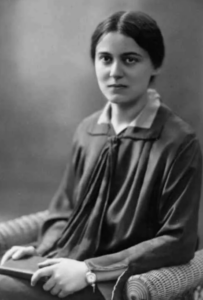
Edith Stein was born in 1891 to a Jewish family living in Breslau, Germany. From a very young age she was intellectually curious and loved to learn. She rejected her family’s Jewish piety and even God because her observation was that people acted as though they did not believe in God. She was a brilliant university student and graduated summa cum laude with a doctoral degree in philosophy. She became the assistant to one of the most influential philosophers of the 20th century, Edmund Husserl, who recognized and admired her intellectual gifts.
In 1921 Edith had a conversion experience. At age 30, she began reading the autobiography of St. Teresa of Avila in a friend’s library and couldn’t put it down. “This is the truth!” she exclaimed. She converted to Catholicism and was baptized on New Year’s Day, 1922.
Edith soon became well regarded as a Catholic philosopher and author. She left her university appointment as Husserl’s assistant and took a position teaching at a Dominican college for women teachers in Speyer, Germany. While there, she studied the philosophy of St. Thomas Aquinas and published the first German translation of his treatise The Truth. She also lectured widely to Catholic women’s groups throughout Europe.
Edith was passionate about her teaching, writing and lectures, but she yearned for a deeper relationship with God. In 1933 she entered religious formation in the Carmelite community at Cologne, Germany and made her final vows on Easter Sunday 1935, taking the name Teresa Benedicta of the Cross.
As the persecution of Jews in Germany intensified in the late 30s, Sister Teresa Benedicta was taken out of the country. On New Year’s Eve 1938, she secretly crossed the border into the Netherlands where she was welcomed by the Carmelite community at Echt. There she would write her final book, The Science of the Cross, a study of the spirituality of St. John of the Cross.
The German Army invaded the Netherlands in 1940 and Sister Teresa’s situation would again become perilous. She and her sister Rosa, also a Catholic convert, were eventually arrested and transported by cattle train to Auschwitz, where they perished in a gas chamber on August 9, 1942.
In his homily at the time of her canonization in 1998, St. John Paul II said: “St. Teresa Benedicta of the Cross says to us all: ‘Do not accept anything as the truth if it lacks love. And do not accept anything as love which lacks truth!’” The feast day of Saint Teresa Benedicta of the Cross is August 9.
Stewardship Saint for September
Saint Teresa of Calcutta

Saint Teresa of Calcutta gave us an extraordinary example of Christian discipleship and stewardship by her faith, simplicity and service to women and men without considering their race, religion or nationality. She was born Agnes Bojaxhiu in Albania on August 26, 1910, and at age 18 went to Ireland to join the Sisters of Loreto following what she discerned to be a call to become a missionary.
She was sent to India in 1929, and began her novitiate in Darjeeling near the Himalayan Mountains. Eight years later she made her solemn vows and took the name Teresa after Saint Thérèse of Lisieux, the patron saint of missionaries. From there she taught at the Loreto convent school in Calcutta for almost twenty years. Though a dedicated educator, she was increasingly disturbed by the desperate poverty in Calcutta.
On September 10, 1946, Sister Teresa had an extraordinary conversion experience, what she later described as “the call within the call.” While traveling by train from Calcutta to the Loreto convent in Darjeeling she experienced interior visions that led her to the conviction that Christ was calling her to serve “the poorest of the poor.”
In 1948 after a few months of medical training, Sister Teresa ventured out into the slums to tend to the needs of the destitute and starving. Her first year was very difficult. She had no income and had to resort to begging for food and supplies. She experienced loneliness, doubt and the temptation to return to the comfort of convent life. But at the beginning of 1949 she was joined by a group of young women who wished to be a part of her ministry.
In 1950 “Mother” Teresa’s community was formally recognized by the Vatican. Its mission was to care for, in her own words, “the hungry, the naked, the homeless, the crippled, the blind, the lepers, all those people who feel unwanted, unloved, uncared for throughout society, people that have become a burden to the society and are shunned by everyone.” In 1952, she opened a hospice for the poor. Then she established several leprosy clinics throughout Calcutta, providing medication, bandages and food. In 1955, she created a home for orphans and homeless youth.
The Missionaries of Charity soon began to attract both recruits and charitable donations, and by the 1960s had opened hospices, orphanages and leper homes all over India. Mother Teresa then went global. Her first mission outside of India was in Venezuela in 1965, then in Rome, Tanzania and Austria. During the 1970s the congregation started missions in dozens of countries in Asia, Africa, Europe and the United States. In 1979, she was awarded the Nobel Peace Prize.
Mother Teresa died on September 5, 1997, departing a religious community with over 4,000 sisters operating 610 missions in 123 countries and aided by more than one million co-workers. Former U.N. Secretary-General, Javier Pérez de Cuéllar, said of Saint Teresa: “She is the United Nations. She is peace in the world.”
Saint Teresa of Calcutta was canonized on September 4, 2016 by Pope Francis. Her feast day is September 5.
Stewardship Saint for October
St. Theresa of the Child Jesus, or Theresa of Lisieux
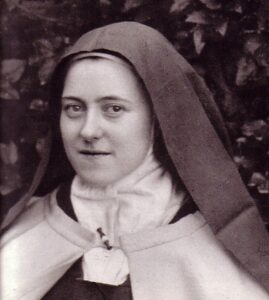
Saint Theresa of the Child Jesus, or Theresa of Lisieux, is a model stewardship saint because of her simple and practical way of life. Better known as the “Little Flower,” Theresa was an extremely popular saint in the first half of the twentieth century. Born in France in 1873 to a very pious family, Marie Francoise Therese Martin became a Carmelite nun at Lisieux, France, at the age of fifteen. She dedicated her life to growing in holiness in a very simple and straightforward way. She meditated on the Sacred Scriptures as well as the writings of famous saints such as Teresa of Avila, Francis de Sales and John of the Cross. She was faithful to the Carmelite Rule and the rhythm of daily life and worship in her religious community. Theresa believed that authentic holiness could be grasped by anyone. It was not just a pious ideal available only to clergy and religious.
In 1895 she suffered the initial stages of tuberculosis, the disease that eventually caused her death. And in the last two years of her life she remained at Lisieux and wrote a spiritual autobiography, The Story of a Soul, which became immensely popular and was translated into several languages after her death. She made a well-known promise to spend her life in heaven continuing to do good works on earth, “as long as there were souls to be saved.” She said she would let fall a “shower of roses” from heaven.
St. Theresa died in 1897 at the age of 24. She was canonized in 1925, an amazingly short length of time since her death. She was declared a Doctor of the Church by Saint John Paul II in 1997. Theresa of Lisieux is the patron saint of the missions, florists, aviators, and the countries France and Russia. Her feast day is October 1.
Stewardship Saint for November
Saint Frances Xavier Cabrini
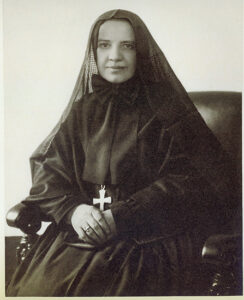
St. Frances Cabrini, better known as Mother Cabrini, was the first American citizen to be elevated to sainthood by the Catholic Church. Born in 1850, near Milan in northern Italy, she was the youngest of 13 children. As a young girl she was fascinated by the stories of missionaries and made up her mind to join a religious order. She tried twice to enter religious communities but was turned down both times because of poor health.
Having earned a teaching certificate, she became a school-teacher in a girls’ school, and eventually became headmistress of an orphanage where she drew a small community of women together to live a religious way of life.
Gaining the attention of the local bishop for their way of life and their care of poor children in schools and hospitals, Cabrini and six other women took religious vows and in 1880, their community, the Missionary Sisters of the Sacred Heart of Jesus, was officially approved.
Sister Frances Cabrini dreamt of being a missionary in China, but Pope Leo XIII had other plans for her. He asked her to travel to the United States and minister to the Italian immigrant community in New York. She made that journey in 1889 with the six members of her community.
Said to have possessed remarkable administrative abilities, Frances Cabrini was responsible for the establishment of nearly seventy orphanages, schools and hospitals, scattered over eight countries in Europe, North America and in parts of Latin America.
There is much that can be learned first-hand about Mother Cabrini because of the letters and diaries she left behind. A very prayerful person, she was able to accomplish in her work what others said could not be done. And even as she was maintaining schools and hospitals and in charge of hundreds of nuns, she was ever mindful to care for the poor, the homeless and immigrants who were without jobs.
Frances Cabrini’s legacy continues today through the Missionary Sisters, their lay collaborators and in the innumerable religious institutions that bear her name. Her charism continues to inspire thousands who serve the poor in schools, hospitals and other ministries around the world.
St. Frances Cabrini died in Chicago in 1917 at the age of 67 and was proclaimed a saint in 1946. She is the patron saint of immigrants and hospital administrators. Her feast day is celebrated on November 13.
Stewardship Saint for December
Saint John, Apostle, Evangelist and Protector of the Blessed Mother
At the foot of his cross, when Jesus looked down “and saw his mother and the disciple whom he loved, he said to his mother, ‘Woman, behold your son.’ Then he said to the disciple, ‘Behold your mother.’ And from that hour, the disciple took Mary into his home” (John 19:26-27). The disciple Jesus is referring to is Saint John, who would be the apostle who cared for Our Blessed Mother until she was assumed into heaven.
John was one of the twelve apostles and considered to be the author of the Fourth Gospel. The son of Zebedee, John was, like his brother James, one of the first disciples called by Jesus, who gave the two brothers the name “Sons of Thunder” for their zeal. They were very close to Jesus and were with him at his Transfiguration. John is identified as the Beloved Disciple who reclined next to Jesus at the Last Supper, ran with Saint Peter to the tomb of Jesus on Easter morning and who first recognized the Risen Lord at the Sea of Tiberias.
John played a leading role in the first Christian community in Jerusalem and is designated in the Acts of the Apostles as second to Peter in the upper room. He accompanied Peter to preach in the Temple, where they were both arrested and he traveled to Samaria to minister to the new Christian converts.
John is traditionally regarded as the author of four more New Testament texts besides the Gospel of John: the book of Revelation, and three letters. In the eighteenth century, Pope Benedict XIV, a renowned scholar, accumulated evidence and traditions and wrote in his Treatise on the Holy Mysteries on Holy Friday that in order to ensure her safety from the persecutions being committed in Jerusalem at the time, took Mary to live with him in the Christian community at Ephesus, located in Asia Minor: He wrote: “Saint John, leaving for Ephesus, took Mary with him and it was there that the Blessed Mother was assumed into heaven.”
Saint Jerome, the most famous biblical scholar in the history of the Church, reported that when his age, most likely in his 90s, made it impossible for John to preach, he would be carried to the assembly and was in the habit of saying, “My little children, love one another.” When asked why he always used the same words, he is said to have replied, “Because it is the word of the Lord, and if you keep it, that is enough.”
Saint John passed away in Ephesus sometime between the years 100 and 117. He is the patron saint of Turkey and Asia Minor. His feast day is December 27.
Stewardship Saint for January
Saint André Bessette, C.S.C.
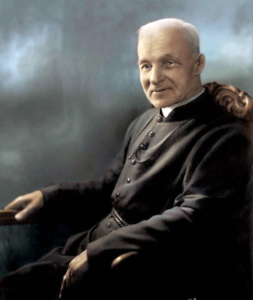
Saint Andre Bessette was born in 1845 in the village of Saint-Grẻgoire d’Iberville, in what is now the Archdiocese of Montreal, Canada. Baptized as Alfred, by the time he was 12 he had to work because both of his parents had died. At age 22 he moved to the United States, where he labored alternately in mills and on farms in New England. He returned to Montreal where he joined the Congregation of Holy Cross in 1870 with the encouragement of Father André Provençal, who had observed Alfred spending whole nights in prayer and sent a note with Alfred that read, “I am sending you a saint.”
Alfred made his final vows in 1874 and was given the religious name of André. For some forty years Brother Andre served as janitor, porter, infirmarian, gardener, baker of the altar bread and in other capacities at the College of Our Lady of the Snows near Montreal. In 1905, at age 60, Brother Andre was transferred to Montreal.
From his childhood Brother Andre had a strong devotion to Saint Joseph and spent his life promoting devotion to the foster-father of Jesus. He founded and helped to build the Oratory of St. Joseph. The popularity of the oratory grew as it became a place of pilgrimage because of the many healings attributed to the intercession of Brother André and Saint Joseph. It was referred to as the “Lourdes of Canada,” and became one of the most popular shrines in North America drawing millions of pilgrims to Montreal.
Much attention centered on Brother André himself because of the number of cures that were attributed to him, so many, in fact, that he was called the “Miracle Man of Montreal.” Brother Andre died on January 6, 1937, at age 91. Over a million mourners processed past his casket. He was beatified by Saint John Paul II in 1982 and he was canonized a saint in 2010 by Pope Benedict XVI. His feast is on January 6.
Stewardship Saint for February
Saint Maroun, Father of the Maronite Catholic community
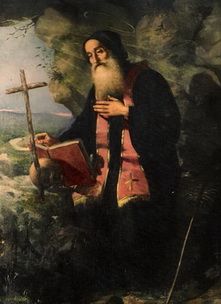
The Maronite Catholic Church, an Eastern Rite Catholic community, celebrates the feast of Saint Maroun on February 9. Saint Maroun is considered the father of the Maronite Catholic community, which professes the same apostolic faith, celebrates the same sacraments and is united with the chief shepherd of the Church, the pope, as are all Roman Catholics throughout the world.
Based in part on the writings of Saint John Chrysostom (feast, Sept. 13), Saint Maroun’s life is dated at approximately 350-410. Saints Maroun and John Chrysostom are believed to have studied together in the great Christian learning center at Antioch, which at the time was the third largest city in the Roman Empire.
Unlike Saint John Chrysostom, who became Archbishop of Constantinople, Saint Maroun embraced a life of quiet, prayerful solitude in the mountains of Syria. He was known for his simplicity and his extraordinary desire to discover God’s presence in all things. He was also known for his evangelization efforts and his extensive healing ministry. He shared his deep commitment to Christ with everyone he encountered.
Saint Maroun’s missionary work came to fruition when he converted an entire pagan community living in the mountains of Syria to Christianity. This
was the beginning of mass conversions to Christianity in Syria. Saint Maroun attracted a multitude of followers and drew attention throughout the empire.
His influence on the Syrian Christians was so great they took their name after him, “Maronites.” In time, the Maronite movement spread the Christian faith to Lebanon where its influence was even more profound.
Saint Maroun is the patron saint of Lebanon, which celebrates his feast day as a national civic holiday for Christians and Muslims alike. Pope Benedict XVI established the granting of a plenary indulgence to anyone who visits a Maronite church on February 9th.
Stewardship Saint for March
Saint Patrick

Saint Patrick, the “apostle to Ireland,” is one of the world’s most famous and celebrated saints. His missionary zeal arguably matched that of Saint Paul, whose missionary activities, though oftentimes a severe struggle, remained in the territories governed by Roman law. Saint Patrick, however, was the first recorded Christian missionary to evangelize beyond the bounds of Roman rule and into the darkness of what was then considered the end of the earth.
“Patricius” was born in Roman Britain around 385. His father was a public official and church deacon. He was kidnapped by Irish slave traders while in his mid-teens and forced into slavery; herding sheep on remote Irish hillsides under harsh conditions. Spending most of his time in solitude, he grew to trust in God and embrace a life of prayer. After six years, he made a dangerous and harrowing escape over land and sea that finally resulted in a return to his parents. They found him, at age 22, a serious visionary who sought holiness and friendship with Christ.
Patrick entered the priesthood, and in time, was sent to evangelize the Irish. He was appointed the bishop of Ireland in 435 and established his see at Armagh in the north.
The Irish were known to be wild, unrestrained and corrupt. But Patrick’s success in making converts to Christianity was nothing less than astonishing, even to him. He traveled to most parts of Ireland, winning the hearts of the Celtic people by his deep faith, humility, simplicity and pastoral care. He took great measures to incorporate pagan rituals into his teachings on Christianity. Since the ancient Celts honored their gods with fire, Patrick used bonfires to celebrate Easter; and he placed the sun, a powerful Celtic symbol, around the Christian cross to create the now familiar Celtic cross.
Patrick’s profound witness to the Gospel eventually brought an end to human sacrifices, trafficking of women, and slavery in general. He is the first person in recorded history to publicly oppose slavery; a protest that would not be taken up again for another millennium.
His writings reveal a keen understanding of stewardship as well. He wrote that whatever good he had been able to accomplish on behalf of the Lord, in his “meager, unlearned, and sinful state … has been a gift from God.”
Over the centuries, Irish immigrants would spread their devotion to Saint Patrick as they established the Catholic faith around the world. He is thought to have died on March 17, 461, the date which became his feast day.
Stewardship Saint for April
Saint Peter Chanel
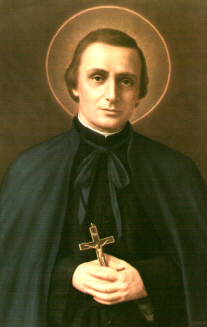
Peter Chanel was born in a small village near Lyons, France in 1803. Observing his simple piety and intelligence, his parish priest had him admitted to a church-sponsored school. Chanel eventually studied for the priesthood and was ordained a priest for the Diocese of Belley in 1827. His mind was set on missionary work and after four years of parish ministry, he joined a recently formed religious community of missionary priests called the Society of Mary, the Marists. Father Chanel sought an assignment to a foreign mission, but instead was sent to teach in the local seminary where he soon became a spiritual director and the vice rector.
In 1836, the Marist congregation was assigned a vast area in the South Pacific for its mission work. Very little was known of the New Hebrides, the colonial name for the island group that now forms the nation of Vanuatu. But a delighted Father Chanel was appointed superior of a small group of missionaries that travelled to the area. They split up and Father Chanel went to the Island of Futuna, between Fiji and French Samoa, accompanied by a lay brother and an English layman. They were received by the island inhabitants with much hospitality and soon earned a great deal of respect for their care of the sick.
Once the missionaries learned the local language and began preaching directly to the people, the king of the islanders became disturbed that Christianity would pose a threat to his sovereignty. When his son asked to be baptized, the angered king sent warriors to assassinate Father Chanel. On April 28, 1841, Father Chanel was killed with an axe and his body cut up with knives.
Two weeks after the killing, a passing American trading ship took Father Chanel’s companions and others to New Zealand and safety. The French landed the following year to make official inquiries and to take Father Chanel’s remains with them. By the time of their arrival, however, the entire island nation had converted to Christianity.
Father Chanel was declared a martyr and was canonized in 1954. His relics were returned to Futuna in 1977.
Saint Peter Chanel’s feast day is April 28.
Stewardship Saint for May
Saint Bede the Venerable
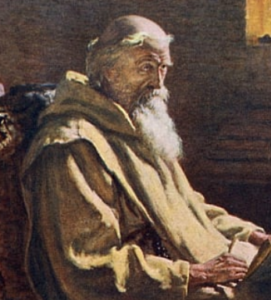
Saint Bede the Venerable, an English saint more popularly known as the “Venerable Bede,” was born in Sunderland, England in the year 673. Educated from the age of seven, he entered the monastery of Saint Peter in Jarrow, Northumberland, England, was ordained a deacon at age 19 and ordained a priest at age 30. The monastery at Jarrow would become the center of AngloSaxon learning in England, and from that monastery Saint Bede, who would remain there his entire life, became the greatest of the Anglo-Saxon scholars.
Saint Bede sought to exercise good stewardship by a balanced life of prayer, scholarship and manual labor. He rarely traveled, but attended faithfully to his monastic duties, working in the fields surrounding the monastery and being partly responsible for the upkeep and maintenance of the large abbey church.
His communal prayer life was complemented by meditation, chanting of psalms and writing prayers, prose and poems that reflected his deep faith.
Saint Bede devoted himself to the study and teaching of Sacred Scripture, and to writing Biblical commentaries based on the Biblical commentaries of the Fathers of the Church and to the lives of the saints. He also taught Latin to those who entered the monastery or came for an education.
The term “A.D.” (Anno Domini, Latin for “year of the Lord”) for the years of the Christian era was popularized by Saint Bede. His Ecclesiastical History of the English People, completed in 731, was widely read throughout England and Europe and became a classic. His book is still reprinted and studied.
The Venerable Bede passed away on May 26, 735. In the final weeks of his life, he completed the translation of the Gospel of John into Old English (his native tongue) by dictating to the young monk who served as his scribe. It is said that he passed away chanting the doxology “Glory be to the Father and to the Son and to the Holy Spirit.”
Pope Leo XIII named Saint Bede a Doctor of the Church. He is renowned as the most important historian of the Church in England and is the patron saint of scholars. His feast day is May 25.